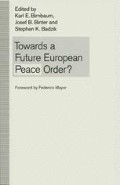Abstract
The pilot semester of the European University Centre for Peace Studies in the spring of 1990 took place at a time of rapid and profound change of the political landscape in Europe. It was therefore natural that in addition to a variety of basic subjects of advanced peace research both students and faculty were anxious to analyse the wider repercussions of ongoing political and societal processes. Two themes in particular attracted our attention: (1) the interaction between social movements and governmental policy, and (2) the prospects and requirements for establishing a new framework of durable and just peace on the ‘Old Continent’, for a peaceful order in Europe. The two themes are obviously interrelated; they were at the heart of the teaching efforts of two members of the core faculty: Professor Nigel Young and myself.
Access this chapter
Tax calculation will be finalised at checkout
Purchases are for personal use only
Preview
Unable to display preview. Download preview PDF.
Notes and References
See for instance: Dieter Senghaas, Europa 2000: Ein Friedensplan (Europe 2000: A Peace Plan) (Frankfurt am Main: Suhrkamp, 1990) pp. 8, 112 and passim.
Also: Pierre Massner, ‘Europe beyond partition and unity: disintegration or reconstruction?’, International Affairs, vol. 66, no. 3 (London: 1990) pp. 461–475.
Cf. Alois Mertes, ‘Friedenserhaltung und Friedensgestaltung in Europa’ (Peace-keeping and Peace-making in Europe), DGFK Jahrbuch 1982/83, ed. by the Deutsche Gesellschaft für Friedens-und Konfliktforschung (German Association for Peace and Conflict Research) (Baden-Baden, 1983).
Peter Glotz has convincingly argued in favour of grass-roots initiatives and warned against what he termed ‘ordnungspolitischer Fanatismus’ (the fanaticism of the politics of order) in the construction of a new Europe.
See his article: ‘Gesamteuropa: Skizze für einen schwiergen Weg’ (All of Europe: Outline for a difficult way), Europa Archiv, 2/1990.
Cf. Fritz Stern, ‘The Common House of Europe’, The New York Review of Books, 7 December 1989. He referred to the US and USSR only, by 1990 this observation was relevant to Western reactions at large.
The characterization is Ian Davidson’s in his article The search for a new order in Europe’, International Affairs (London, 2/1990) p. 276.
also Berndt von Staden, ‘Nothing less than the whole of Europe …’, Aussenpolitik (8/1990) pp. 24–37.
Editor information
Editors and Affiliations
Copyright information
© 1991 European University Centre for Peace Studies
About this chapter
Cite this chapter
Birnbaum, K.E. (1991). Introduction: Perspectives for a European Peace Order. In: Birnbaum, K.E., Binter, J.B., Badzik, S.K. (eds) Towards a Future European Peace Order?. Palgrave Macmillan, London. https://doi.org/10.1007/978-1-349-12189-2_1
Download citation
DOI: https://doi.org/10.1007/978-1-349-12189-2_1
Publisher Name: Palgrave Macmillan, London
Print ISBN: 978-1-349-12191-5
Online ISBN: 978-1-349-12189-2
eBook Packages: Palgrave Political & Intern. Studies CollectionPolitical Science and International Studies (R0)

